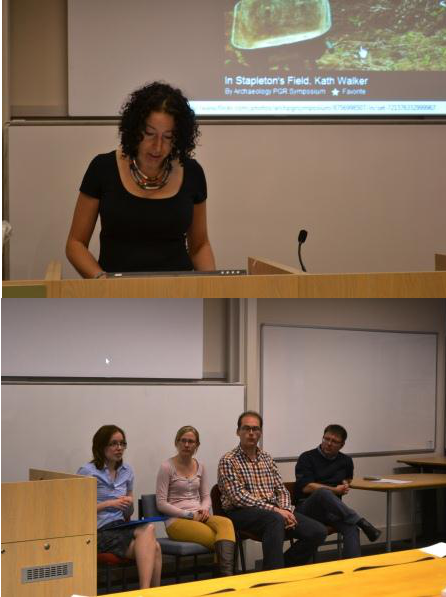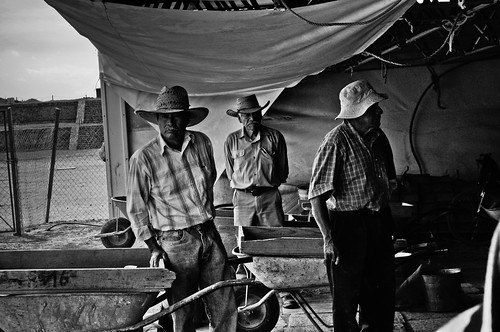PGRAS 2013
The Postgraduate Research Archaeology Symposium is a two day event that allows the entire University of Southampton Archaeology postgraduate research community to share their research, and have feedback from other members of the faculty.
PGRAS 2013 will be held on the 23rd-24th May in building 65, Avenue Campus.
PGRAS 2013 – Post-Symposium Reflections
May 28, 2013
by Mark Almond
I am pleased to say that the Postgraduate Research Archaeology Symposium 2013 was a great success! Not only was there a great set of presentations from our PGR students, but also a great turn out of students and staff to hear them present. Post-presentation discussion was lively and constructive, and cake-fueled coffee breaks were filled with conversations about interesting cross-overs between different people’s research.

PGR coordinator Jo Sofaer welcoming everyone to PGRAS 2013 (top) Post-presentation discussion on ‘Ownership and Display’ (bottom)
We also managed to tick off all our archaeological buzzwords on our bingo sheets (thanks in part to some elaborately constructed questions from John McNabb).
Our cake and book stalls raised £205 for MacMillan Cancer Support and The Brooke. Thanks to everyone who donated cakes and books, and also everyone who bought something delicious or informative.
The symposium was rounded off by a fantastic keynote from Prof Chris Stringer from the Natural History Museum on “Current Status of Homo heidelbergensis”.
Thanks
The symposium was made possible through the hard work of the PGRAS committee, led by Lizzie Norton, consisting of: Richard Chuang, Sarah Green, Brittany Hill, Lizzie Richley and myself. We also relied on a team of volunteers throughout the two days to help with the cake and books stalls, as well as loading presentations- thanks to all those who volunteered!
We would like to thank Jo Sofaer for her support as PGR coordinator, as well as all those who presented for their hard work.
PGRAS 2013 Begins
May 23, 2013
by Mark Almond
PGRAS 2013 has begun! PGR coordinator Jo Sofaer is now introducing the event. Drop by throughout the day to see presentations from the archaeology PGR community.
In the mouth of Quetzalcoatl
May 18, 2013
by Rodrigo Pacheco-Ruiz
Going back to Teotihuacan for me is like travelling back in time. ‘In the mouth of Quetzalcoatl’ shows a snapshot of how Mexican archaeology is and has been in the last decades. It shows the wrinkles of time through the people and places involved in understanding a disappeared past. The history of Mexican archaeology is still strikingly visual and it is present through the actors and sceneries of every day’s life.
This shot taken in March 2013, not only freezes the essence of a country’s curiosity to learn more about its people, it also throws me back in time. This was the place where I started my career as an archaeologist, more than ten years ago and it is linked to a rather curious story.
Teotihuacan is known to be the largest and most important prehistoric city in America, extending some 83 square kilometres in the Teotihuacan valley. The ancient city is also known to be the number one place for archaeological testing grounds. From excavations with dynamite in the late 19th Century, to state of the art research today – Teotihuacan has seen it all. My story nevertheless, is the combination of human curiosity, ingenuity and recklessness.
The city is one of the earliest examples of prehistoric urbanism in the continent and it is organised along two main large roads, one oriented north south and the other east west. Each barrio, or cluster of buildings, presents a large courtyard, surrounded by four temples, one at each cardinal point. Whilst excavating one of the small complexes, the perfect test bed for novice students, a rumour reached us.
Archaeologists working at the largest and most important courtyard complex, found a collapsed slate at courtyard level. This uncovered an old vertical shaft of roughly a metre in diameter, which dropped twenty metres to the heart of the earth. The rumour was exciting for every one, until we heard the rest of the message. Someone was trying to strap a child to a rope and lower him down to report back what he found there, in the underworld.
This created a wave of alarmed whispers that echoed along the trench we were working on. Despite everybody’s clear outrage, the only souls in complete silence were the students. I don’t know if this was because they couldn’t believe what they were listening or they were just remaining as inconspicuous as possible, in case they turn to be a suitable candidate for the task. Personally I couldn’t believe what was happening.
Later in the evening, we met the archaeologists in the main restaurant. After a few tequilas, I took courage to inform the main archaeologist in charge of this stupid idea, the way I thought about his approach. This was nevertheless easier to think than to say, so we started talking about the incredible find and what it could represent for Mexican archaeology. I then received a very kind invitation to visit the site the next day.
I found myself at 10:00 in the morning looking down this very dark hole in the ground, strapped around an old piece of rope, descending very slowly down the mouth of Quetzalcoatl. At this point I didn’t know what thought was more powerful in my head, the fact that I was probably the first person to be there in more than two thousand years, or my mother’s idea that I finally had lost my mind completely.
Today Quetzalcoatl temple project is one of the most important archaeological projects in Mexico and although no more human testing is done it keeps producing generations of archaeologists. After more than eight hundred tons of meticulously excavated soil, more than thousands of objects recovered and eleven years of excavations, the heart of the temple has not yet been reached.
PGRAS Charity Book & Cake Sale
May 17, 2013
by Mark Almond
Every year the Post-graduate Research Archaeology Symposium (23rd-24th May) has a second-hand book sale and cake sale to raise money for charity.
In the last three years, we have commemorated loved ones by raising a total of £750 for Glencoe Mountain Rescue, the Mexican Association for the Fight Against Cancer, and Action on Addiction. This year, the collection is (fortunately!) not as personal as it has been in previous years. Nonetheless, the charities were chosen with care:
Macmillan Cancer Care relies on donations for 98% of their income.
Our second charity, The Brooke, provides veterinary care for work animals in Africa, Latin America, and Asia. Horses, donkeys and such.
Both the cake and book sale depend very much on your generosity. If you can donate any unwanted archaeological or non fiction books to the stall, please do. There is a box in the photocopy room (ground floor of 65a) marked “PGRAS BOOKS” to receive your donations. Alternatively, contact pgras@soton.ac.uk and we can arrange to collect the books from you. If you would like to bake a cake for us, contact us by email and let us know.
Also don’t forget to drop by the stalls next Thursday and Friday!
Call for Papers
March 19, 2013
by Mark Almond
Hi all, the call for papers for PGRAS 2013 is out now – check it out. PGRAS is a two day symposium that allows research students to share their ideas and get valuable feedback from staff and students. We hope you will enjoy this year’s event and make the most of the opportunity to discuss your work. All full time PhD students are obliged to present, part time students are expected to present every other year. Get those abstracts in now!
Date for PGRAS 2013
February 27, 2013
by Hembo Pagi
The annual Archaeology PGR Symposium will be held on 23-24th May. Hold these dates in your diary!


